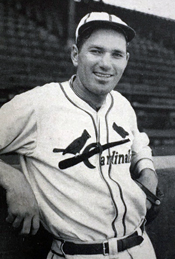Dizzy Dean was plenty good for the 1934 Cardinals, but he needed a helping hand from an influential source to achieve 30 wins.
 In two June relief appearances Dean made for the 1934 Cardinals, National League president John Heydler credited him with wins in both, even though other pitchers appeared to qualify instead.
In two June relief appearances Dean made for the 1934 Cardinals, National League president John Heydler credited him with wins in both, even though other pitchers appeared to qualify instead.
If not for Heydler’s unconventional decisions, Dean would have finished with 28 regular-season wins in 1934. Instead, he got 30, becoming the last National League pitcher to achieve the feat.
Save or win?
On June 21, 1934, at St. Louis, Dean beat the Dodgers, pitching a complete game and boosting his season record to 10-3. Boxscore
Two days later, with the Dodgers ahead, 3-0, in the sixth inning, Bill Hallahan relieved for the Cardinals and gave up a run, extending the Brooklyn lead to 4-0. In the bottom half of the inning, Pat Crawford batted for Hallahan and delivered a two-run single, capping a five-run rally that put the Cardinals on top, 5-4.
Dean entered in the seventh, looking to protect the lead. Hallahan figured to be in line for the win if the Cardinals held on. Dean did the job, holding the Dodgers scoreless the last three innings. Boxscore
Official scorer Martin Haley, baseball reporter for the St. Louis Globe-Democrat, awarded the win to Hallahan because the Cardinals were ahead when Dean was brought in.
As the St. Louis Post-Dispatch noted, “The official scorer, in naming Hallahan, was abiding by the scoring rules, which provide that ordinarily a pitcher shall be credited with the runs scored by his team in the inning, or innings, he pitches.”
Haley apparently had second thoughts, though, because that night he filed a report to Heydler, a former umpire, and asked him to make a decision on who should be the winning pitcher. Dean, the fourth Cardinals pitcher of the game, was the only one who held the Dodgers scoreless.
Rules to pitch by
Here is how Major League Baseball defines how a pitcher qualifies for a win:
“A pitcher receives a win when he is the pitcher of record when his team takes the lead for good _ with a couple rare exceptions. First, a starting pitcher must pitch at least five innings (in a traditional game of nine innings or longer) to qualify for the win. If he does not, the official scorer awards the win to the most effective relief pitcher.
“There is also a rarely used clause where an official scorer can deem a relief pitcher’s appearance ‘brief and ineffective.’ (For example, if a reliever relinquished a one-run lead by allowing three runs, but was still in line for a win after his team scored four runs in the following inning _ that may qualify.) If that’s the case, the scorer can award the win to a pitcher who followed that ‘brief and ineffective’ pitcher. Which relief pitcher earns the win specifically is also up to the judgment of the official scorer.”
Verdict is in
On the morning of June 27, 1934, Heydler declared Dean the winning pitcher of the June 23 game. “Dean pitched great ball … to protect (a) one-run lead,” Heydler ruled. “Hallahan pitched one inning rather poorly.”
According to the Brooklyn Daily Eagle, “Hallahan himself suggested that the credit go to Dean.”
St. Louis newspapers supported Heydler’s decision.:
_ St. Louis Star-Times: “Hallahan, like Diz, entered the contest as a relief pitcher but, unlike Diz, failed to hold the foe in check.”
_ St. Louis Post-Dispatch: “It was (Dean’s) strong arm and determination, his pitching skill and his fielding agility that made it possible for the Cardinals to win.”
Heydler’s ruling gave Dean a season record of 11-3.
That afternoon, the Cardinals played the Giants at St. Louis. The groundkeeper’s thermometer at Sportsman’s Park recorded 115 degrees on the field, the New York Daily News reported.
Dizzy started for the Cardinals and labored into the ninth inning. With the score tied at 7-7, the Giants had runners on first and second, two outs, when Jim Mooney relieved Dean.
Mooney, an ex-Giant, got the Cardinals out of the jam when he fielded Mel Ott’s sharp grounder and threw to first for the third out. Ott’s comebacker “almost knocked the pitcher down,” the Post-Dispatch reported, but he made the play.
Facing 43-year-old reliever Dolf Luque in the bottom half of the ninth, Cardinals catcher Bill DeLancey drove a pitch onto the pavilion roof in right-center for a walkoff home run. Boxscore
Decisions, decisions
Though Mooney had done the job, retiring a future Hall of Famer with the outcome on the line, and was still in the game when Delancey hit his homer, official scorer Martin Haley awarded the win to Dean.
“He had toiled 8.2 innings under a blistering sun and had pitched shutout baseball from the third to that ninth,” the Post-Dispatch noted.
He also may have pitched with a hand injury. According to Dean, an X-ray showed a small piece of bone chipped off the knuckle, the Globe-Democrat reported.
Seeking cover for his decision, Haley again asked Heydler to make the final ruling. Heydler agreed with him. Dean got the win, improving his season record to 12-3.
In his book “Diz,” Dean biographer Robert Gregory wrote that the two rulings giving wins to Dean “were controversial” and the Giants “were said to be particularly indignant.”
Dean finished the 1934 regular season with a 30-7 record. In 33 starts, he pitched 24 complete games, including seven shutouts, and was 26-5. He was 4-2, including the two Heydler rulings, in 17 relief appearances. In three starts against the Tigers in the 1934 World Series, Dean was 2-1, including a shutout in Game 7.
